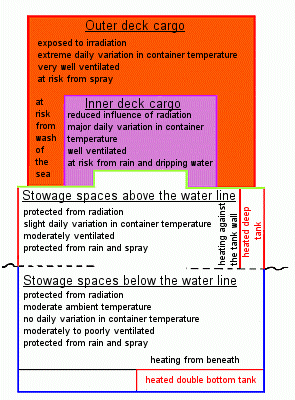Other requirements relating to maintaining cargo quality, such as radiation protection, shipment below deck, protection from heat sources etc., are given little consideration. Opinions will have to change if goods of vegetable origin are to be transported by container in any considerable quantity. The current practice of allocating containers to stowage spaces must of course be accepted for the majority of industrial goods, but is inadequate for sensitive goods.
Fig. 54 shows the different stowage spaces available on board a container ship. The significant difference with regard to cryptoclimate depends on whether the containers are stacked below deck or on the upper deck. None of the containers shipped below deck are exposed to radiant input and they are all protected during the voyage from spray and rainwater.
The daily variation in temperature of the ambient air is considerably more stable than on deck. A disadvantage is the low level of air movement, since the hold ventilation stream has little effect on a closed standard container, though a perceptible air exchange does occur in passively (naturally) ventilated containers. On the other hand, however, open containers packed with moisture-sensitive goods may also be transported below deck, such as citrus fruits on flatracks in the ventilated holds of
ro/ro ships.
 |
Figure 54: Stowage spaces on a container ship; U. Scharnow [42] |
Containers which are transported on deck are exposed to solar radiation. A high degree of daily variation in temperature in the container will occur, resulting in more severe formation of container sweat during night-time cooling, this also being greater than in the hold.
The risks posed by spray and rainwater are also significant. Door and roof leaks are probably the main causes of damage. Only in a few cases will these deficiencies be detected in a packed container.
Packing should consequently be commensurate with the value of the cargo and its sensitivity to moisture.
For instance, containers packed with batteries or high-quality microelectronics or with musical instruments should be stowed in the hold.
The same applies to hygroscopic goods, such as malt or tea. On the other hand, glass or porcelain goods, machine parts etc. suffer less damage when shipped on deck.
On deck too, a distinction may be drawn between the outer and inner layers of containers, the latter being less severely exposed to radiation and spray.
However, even in the hold the individual stowage spaces exhibit different travel temperatures. For instance, a container standing on a heated double bottom cell or a bulkhead to a heavy oil tank will be subject to considerable heating.
Even if modern data-processing were theoretically to allow individual container slot allocation, the operational requirements of the shipping companies and terminal operators would not allow such specially tailored stowage.